私達が普段何気なく行っている習慣の中にも、昔の人の願いや祈りがこめられています。
普段見過ごしがちなその意味を、自分なりに調べてみました。
まだまだ少ないですが、これからどんどん増やして行く予定です。
「こんな事を教えて欲しい」「私の住んでるところではこんな習慣がある」などなど、ご意見ご感想がありましたらこちらからお送りください。
御祈祷
厄祓 諸災祓除
厄年とは、体調不良や災難などにあいやすい年と云われます。厄による災いが起こる前にお祓いを受け、心身ともに健やかで一層充実した日々を送れるように祈願するのが厄祓です。
浅草神社では九星気学というものに基づいて厄年を算出しています。
厄年に当たらない方は、「諸災祓除(しょさいはらいよけ)」という厄祓祈祷を行います。
新年を迎える正月に厄祓を行うことが多いようですが、これに関係なく誕生日など良き日柄を選び、参詣をする場合もあります。
本来、厄年は長寿を祝う還暦や古稀などの年祝いと同じく、ハレの年齢と考えられていました。厄年を迎えることは、地域社会において一定の地位となることを意味し、宮座への加入や神輿担ぎなど、神事に多く関わるようになります。このため心身を清浄に保ち、言動を慎む物忌(ものいみ)に服する必要があったわけです。厄年の「厄」は、神様にお仕えする神役の「役」であるといわれるのも、こうした理由によるものです。
現在では、災難が多く生じる面が強調され、その禁忌の感覚が強くなりましたが、七五三や成人式、年祝いなどとともに、人生における通過儀礼として、大切に考えられていることには変わりありません。
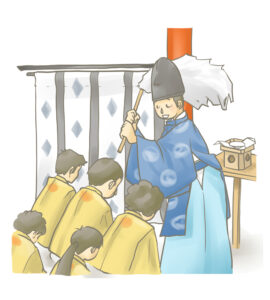
安産祈願
神社でお産の無事をお祈りするのが安産祈願です。
妊娠5ヶ月の「戌の日」などに、丈夫な赤ちゃんを授かるよう願いを込めて参拝します。
戌の日にお参りする由来は、犬の出産が軽く多産であることにあやかっていると云われています。多くの仔犬を短い時間で次々と産んでいく様子から犬は安産の象徴と考えられ、戌の日に安産祈願を行い、新しい命の誕生をお祈りします。
地鎮祭
「とこしずめのまつり」や「じまつり」ともいわれ、もっとも一般的で重要な建築のお祭りです。工事を始める前にその土地の神様にご挨拶し、土地を祓い清め、これから行われる工事の安全と変わらぬ守護を願うお祭りです。
敷地の中に祭壇を設け、お供え物をし、その土地の神様をお迎えし、これから取り掛かる工事の安全を祈願します。

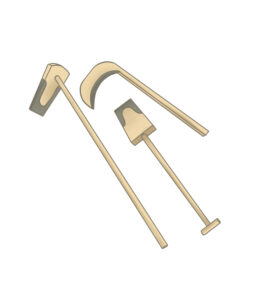
上棟祭
「むねあげ」「たてまえ」ともいわれ、柱が立ち、棟木を上げる際に行われるお祭りです。地鎮祭では土地の神さまをお迎えしますが、上棟祭では建物の神さまや工匠(たくみ)の神さまをお迎えします。
それらの神様と氏神様を記した棟札を中央の柱に貼り、上棟幣を立て、魔除けとして弓矢などを飾り、
曳綱(ひきつな)の儀:棟木を棟に曳きあげる
槌打(つちうち)の儀:棟木を棟に打ち固める
三餅銭(さんぺいせん)の儀:お餅や小銭などを撒く
を行うことが多いようです。
ご近所の方々に、小銭やお餅などを振る舞い、直会では建主が工事関係者の日頃の労をねぎらいます。上棟祭は、建主と工事関係者、ご近所の方々との交流の場でもあるのです。
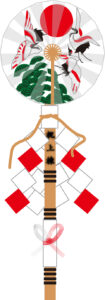
竣工祭
建物が完成し、入居するにあたり行うお祭りです。新築した建物を祓い清め、神様に無事完成したことを奉告し、建物が末長く丈夫であること、そこに住む人々が繁栄することをお祈りします。
~建物のお祭りに関わる神様~
・大地主神(おおとこぬしのかみ)
その土地をお守りくださる神様です。私たちは土地や建物の売買を行いますが、その土地は大地主神さまにお守り頂いているのです。
~匠の神さま~
上棟祭でお迎えする神様です。
建物の神様:屋船久久遅命(やふねくくちのみこと)、屋船豊受気姫命(やふねとようけひめのみこと)
工匠の神様:手置帆負命(たおきほおいのみこと)、彦狭知命(ひこさしりのみこと)
人生儀礼
初宮
赤ちゃんが、生まれて初めて神社にお参りすることを初宮参りと言います。地域差はありますが、一般に男児は生後31日目、女児は33日目に行います。多くは母方から贈られた晴れ着を着せ、父方の祖母が抱き、両親とともに神社にお参りして、神様に赤ちゃんが無事誕生した御礼と、地域の一員として健やかに成長することをお祈りします。
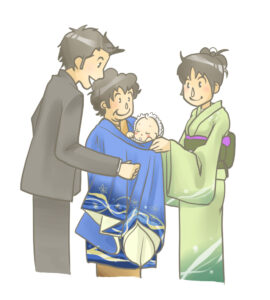
初誕生祭
初誕生祭とは、この世に生を受けたお子様が、節目である一年を無事に迎えられた事に感謝し、これからの健やかな成長を祈る人生儀礼の一つです。
我が国に古くから伝わる習慣で、お子様が風呂敷に包んだ一升餅を背負うことで“一生”の健康と幸せをお願いします。

七五三
七五三をするのはなぜ
「子供は神様からの授かりもの」と言われます。この神様とは氏神様のこと。ですから子供が産まれると、約一ヶ月で氏神様にお宮参りをして報告と感謝をします。そして、「七歳までは神の子」と言われ、生まれてから幼い間は魂がまだ、定着していません。神前で祝いの儀式を繰り返すことによって、魂を固めていくという意味があります。
何故、三・五・七歳に祝うのか?
七五三は江戸時代の武家社会において子供の成長の節目を祝う風習であり、
それぞれを
髪置(かみおき) 三歳
袴着(はかまぎ) 五歳
帯解(おびとき) 七歳
と言いました。
髪置とは、
三歳の男女が頭髪をのばす儀式です。生まれてから三歳頃までは髪を剃り上げていました。

袴着とは、
五歳の男子が初めて袴をはく儀式です。袴をはくことで男としての自覚が生まれます。

帯解とは、
女子が付け帯をといて大人の帯を締める儀式です。付け帯をとり、八つ口をふさいで小袖を着せ、幅広の帯を締めます。魂を内にしっかりととどめ、身を持ち崩さぬ ようにとの願いが込められたと言います。

いずれにしても、三歳は一人歩きをはじめ、五歳はやんちゃで目が離せない、七歳は社会の仲間入り(現代では小学校入学)という、親にとっては心配な時期を七五三というめでたい数字にのせ、家族の笑顔の中で子供の成長を見守るということは、昔も今も、大切なことに変わりありません。
成人奉祝祭
成人を迎えるにあたり、御神前にて神様に奉告します。
成人を祝う儀式は古くからあり、公家、武家を通じて行われていました。
奈良時代以降、数え年で12?16歳の男児が行った「元服(げんぷく)」という儀式、女児の場合は、平安朝の貴族社会で行われた「裳着(もぎ)」という儀式が成人の通過儀礼として行われていました。
現在の成人式の形態は、1946年埼玉県北足立郡蕨町(現:蕨市)において行われた「青年祭」がルーツとなっています。
日本政府により1月15日を成人の日と定められると、多くの地域で成人を祝う祭典が執り行われるようになりました。
現在、成人の日は1月第2月曜日に移動しています。
結婚式
日本の神話の中で、性別を持って生まれた 「いざなぎのみこと」という男神と 「いざなみのみこと」という女神が 天の御柱を巡って結ばれ、この日本に多くの神々をお産みになり、日本という国が始まりました。いざなぎの命といざなみの命の二人の神さまのように深く結ばれ、また新たな命を産み、育み、次世代へ受け継がれていく、結婚式にはそんな願いが込められています。
現在のような神社における結婚式の形は明治33年5月10日皇室婚嫁令により皇太子であった大正天皇と九条節子姫(貞明皇后)が宮中賢所大前において執り行われたご婚儀が大きな影響を与えています。
翌34年、この婚儀に基づき定められた神前結婚式の式次第は一般でも日比谷大神宮(現・東京大神宮)において行われ、全国各地に普及するようになりました。 それ以前の結婚式は、家庭で行うのが通例で、床の間にいざなぎの命、いざなみの命の御神名の掛け軸や自らが信仰する御神名、また縁起物の絵巻の掛け軸などを飾り、その前に御饌御酒を備え、お供えした御神酒を三三九度により新郎新婦がいただくことで、夫婦の契りが結ばれるというものでした。 この伝統的な婚儀の形は、現在の神前結婚式にも受け継がれています。
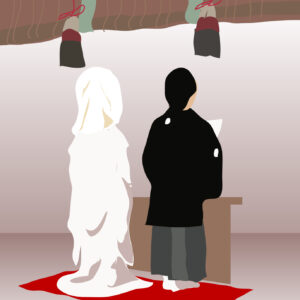
神社の祭事
月次祭
月の初めに、皇室・国家の安泰と国民の繁栄、五穀豊穣、商工業の繁栄、氏子崇敬者の皆さまの健康と家内安全などを神様に祈願します。
浅草神社では毎月1日に月次祭を斎行致します(1月を除く)。どなたさまでもご参列頂けます。参列ご希望の際は浅草神社社務所へお申し込みください。
月の始まりの日に、神職と共に参列することにより、心身の浄化と日々の暮らしの安全をお祈りしましょう。
歳旦祭
歳旦とは1月1日の朝のことです。
歳旦祭とは、新年の訪れを喜び、皇室の弥栄と国家の安泰を祈るとともに、国民の繁栄、五穀豊穣、世界平和など、1年間の加護を祈る行事です。
厳密には、皇居にある賢所(かしこどころ)・皇霊殿(こうれいでん)・神殿(しんでん)という宮中三殿(きゅうちゅうさんでん)で行われる行事で、各地の神社でも年の初めの恒例祭事として行われています。
元始祭
1月3日、天皇陛下が宮中三殿において皇位の始源を祝う、1年の一番始めのお祭りです。全国の神社でも元始祭を斎行します。
初午祭
初午とは、2月3日の節分を過ぎて最初の「午(うま)の日」です。
和銅4年(711年)2月初めの午の日に、穀物の神様「稲荷大神」が稲荷山に鎮座したとされ、その年の初午の日には「初午祭」が全国の稲荷神社で行われます。
春の兆しが感じられる初午に、その年の豊作や商売繁昌を願って稲荷神社を参拝する習慣が現在も続いています。
祈年祭
2月17日に行われるお祭りで、春の耕作のはじめに、その年の五穀豊穣を祈るとともに国家の安寧を祈念します。
「としごいのまつり」とも呼ばれます。
その年の収穫に感謝する11月の新嘗祭と対になるお祭りです。
節分祭
「節分」とは立春の前日を指します。そもそも節分という語は、立春だけに限らず立夏・立秋・立冬の前日をさし、四季の節目を意味していた言葉でした。つまり節分は一年に4回あったわけです。
しかし、旧暦では立春が年の始まりにあたったことから、この節目が特に重要視され、いつしか節分といえば立春の前日を指すようになったのです。
節分には、災厄や邪気を祓う行事が行われますが、その代表的なものに「豆まき」があります。年男年女が「福は内、鬼は外」と唱えながら、煎った大豆をまいて鬼を祓うこの行事は、中国の明の時代の習慣を室町時代に取り入れたと云われています。かつては、豆まきを「追儺(ついな)」「鬼遣らい(おにやらい)」といい、宮中の年中行事の一つでした。舎人(とねり)が扮した疫鬼を追い払うことにより、災厄を祓い除くというこの儀式が、次第に民間に伝わっていったのです。
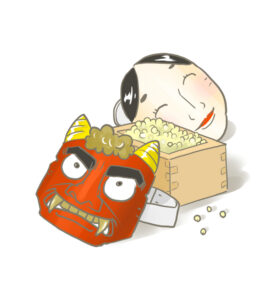
天長祭
今上天皇のお誕生日をお祝いして、天皇陛下のご長寿、皇室の安泰ならびに国民の安寧と繁栄をお祈りするお祭りです。宮中や全国の神社でお祝いの祭典が斎行されます。
神嘗奉祝祭
伊勢の神宮の大祭であり、天照大御神に新穀を捧げるお祭りが神嘗祭です。この神嘗祭を奉祝する祭典が全国の神社で行われます。
新嘗祭
その年の新穀を神様にお供えし、収穫に感謝するお祭りです。
日本書紀にも登場するほど古くから行われてきた行事で、現在では全国各地の神社で11月23日に行われます。
「新」は新穀を、「嘗」は神様にお召し上がりいただくことを意味します。
「にいなめのまつり」「しんじょうさい」と呼ぶこともあり、2月に行われる「祈年祭」と対になるお祭りです。
除夜祭
大晦日の夜に行われる、一年で最後のお祭りです。この1年を無事に過ごせたことに感謝するとともに、心身を清め新しい気持ちで新年を迎えるためのものです。
大祓(年越・夏越)
1年もしくは半年の内に、自分自身が知らず知らずのうちに犯した罪や過ちまた心身の穢れ(けがれ)を祓い清め、本来の清浄な心身に戻り日々の生活を営むための神事です。
この神事は毎年6月30日と12月31日の二回行われ
6月の大祓を『夏越し(なごし)の大祓』、
12月の大祓を『年越しの大祓』と
も言います。
神事には、人形(ひとがた)という祓具(はらいぐ)によるお祓いや、茅輪(ちのわ)くぐり(6月のみ)が挙げられます。
茅輪は、茅草(かやくさ)で作られた大きな輪で、それをくぐることで疫病や罪穢れが祓われると言われています。
茅輪のくぐり方(6月のみ)
左まわり、右まわり、左回りと、八の字を描くように三度くぐりぬけます。こうして、心身共に清らかになって、神社へ参拝します。
浅草神社では、6月15日頃~6月末日まで社殿前に、茅輪を設置致します。
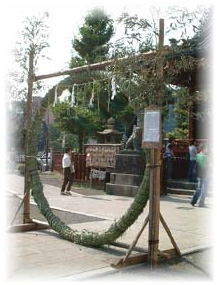

人 形
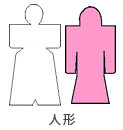
人形は撫物(なでもの)ともいい、紙を人の形に切り抜いた物です。これに名前と年齢を書いて、身体を撫で、息を三回吹きかけます。
そうすることにより、自分の罪穢れを移し、我が身の代わりに清めるというものです。
伝統文化
初詣
お正月の恒例行事「初詣」は、年明けに初めて神社・仏閣を参拝する事を指します。1年の感謝を捧げ、新年の無事と平安を祈願します。
元々は「年籠もり」(としごもり)といい、家長が祈願のため、大晦日の夜から元旦の朝にかけて神社に籠る習慣がありました。
やがて大晦日の夜の「除夜詣」と元日朝の「元日詣」との2つに分かれ、元日詣が今の初詣の原形となりました。
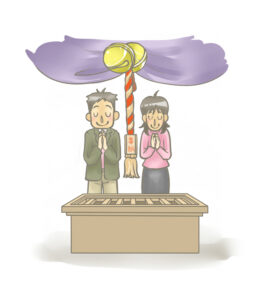
さくら詣
浅草神社では、新年度の新しい生活への区切りとして桜咲く神社に参拝し、心新たに新年度・新生活の無事と益々の隆昌をご祈念いただければと、この桜の時期に合わせて「さくら詣」を行なっています。
この期間限定で、特別な御朱印やお札の授与を行なっております。
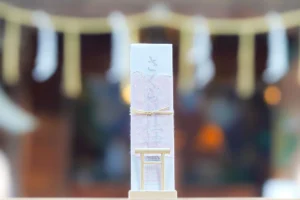
さくら詣は近隣の神社でも行なっておりますので、是非併せてご参拝ください。
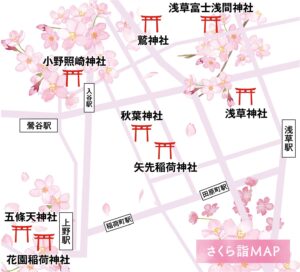
夏詣
「年越の大祓」で1年の罪穢れを祓い清め、翌日の元日は新しい年の始まりとしてその年の平穏を願い神社・仏閣に詣でる「初詣」を行います。
その始まりから6ヶ月、同じく罪穢れを祓い清める「夏越の大祓」を経て、過ぎし半年の無事を感謝し、来る半年の更なる平穏を願うべく、年の半分の節目として7月1日以降にも神社・仏閣を詣でる風習です。
平成26年(2014年)に浅草神社から提唱された「夏詣」は、浅草から台東区、そして東京から全国津々浦々の神社仏閣へ広がりを見せています。
ぜひ、お近くの神社仏閣へ足を運ばれ、「夏詣」をされてみてください。
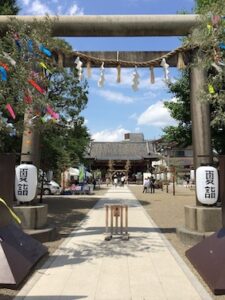
書き初め
年が明けて初めて毛筆で書をしたためることを書き初めといいます。
書き初めは古くから日本で行われてきた伝統的な年中行事の一つで、おめでたい言葉をしたため、目標成就や新年をお祝いする意味が込められています。
1月2日に行うのが一般的です。昔は1月2日が仕事始めとされ、この日から習い事を始めると上達するという言い伝えがあります。
平安時代、年始に文書を天皇陛下へ申し上げた「吉書の奏」が起源とされ、江戸時代の頃は、若水(元旦の早朝に初めて汲んだ水)で墨をすり、その年の吉方に向かった詩歌や文書を書く行事として広がっていきました。
浅草神社では毎年1月3日に小学生向けに「書き初め教室」を開催しています。
十五夜
「十五夜」とは旧暦8月15日、新暦では九月中旬あるいは下旬に、満月を観賞する行事です。「お月見」「名月」「中秋の名月」ともいわれ、昔から月見の好時節として詩歌や俳句の題材ともなっています。
一般的に十五夜には、すすきを花瓶に挿して、団子と里芋や梨など、その時期の成り物を供えて、感謝の気持ちを表します。関西から中国地方にかけては、里芋を供えることから「芋名月」ともいい、もともとは芋類の収穫祭、すなわち畑作儀礼だったと考えられています。
このような月見の習慣は、中国では唐の時代からあり、これが日本に伝来しました。そして、畑作物の収穫に関連する行事へと発展し、現在に至るまで長い間伝承されてきたのです。
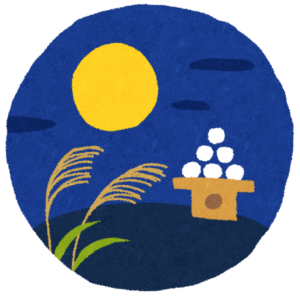
十三夜
十五夜から約1ヶ月後の旧暦9月13日を「十三夜」といい、十五夜に月見をしたら必ず十三夜にも月見をするものとされていました。十五夜だけでは「片見月」といって忌まれていたのです。逆に十五夜を忘れたら十三夜もやらなくて良いそうです。十五夜が「芋名月」に対し十三夜は「豆名月」「栗名月」ともいわれます。豆というのは枝豆のことで、枝豆や栗を供える習慣があります。
五節句
「節句」とは、「季節の節目となる日」のことを言います。 もともと奈良時代頃に中国から伝えられた「陰陽五行説」が由来とされており、当初はたくさんの種類が存在していましたが、日本の文化や生活様式と混ざり合うことで少しずつ減少しました。そして江戸時代になり、幕府が特に重要な節句を公式の祝日に制定したのが「五節句」の由来となります。
・1月7日 人日の節句 七草粥を食べることから、七草の節句ともいい、1年の豊作と無病息災を願います。 古来、中国では1月7日を人の日とし、犯罪者に対する処罰を行わない日としていました。 また、正月の祝膳や祝酒で弱った胃を休めるために7種類の野菜を入れた羹(あつもの)を食する習慣があり、これが日本に伝わって七草粥となりました。
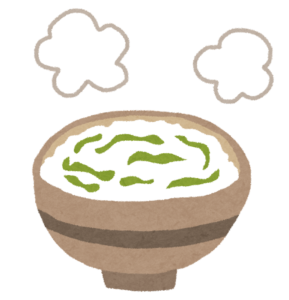
・3月3日 上巳の節句 上巳の節句は、ひな祭りのことで、女の子の健やかな成長を祈る節句です。 人の形を草木や紙でこしらえて、それで身体を撫でて自分の厄を移し、水に流して祓いました。この時の撫でものを人形(ひとがた)と呼び、これが後世のひな人形の始まりではないかと考えられています。

・5月5日 端午の節句 端午の節句は、こどもの日のことで、男の子の健やかな成長を祈る節句です。 別名「菖蒲の節句」と呼ばれ、これは花菖蒲が5月頃に盛りを迎えることと、菖蒲が薬草に使われて強い香りを持ち、邪気を祓うとされていることに由来します。 また、兜や鯉のぼりを飾り、菖蒲湯に浸かる風習もあります。

・7月7日 七夕の節句 短冊に願いを込めて笹に飾ると願いが叶うとされていて、別名「笹の節句」とも言われています。 また、古来日本には「棚機(たなばた)」という着物を織る道具があり、その織物を神様の祀ってある棚にお供えし、手芸の上達や秋の収穫を願い、人々の穢れを祓うための神事が行われていたことも由来しています。
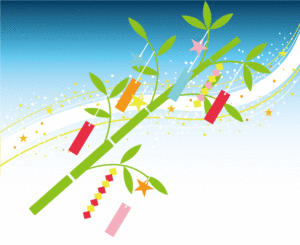
・9月9日 重陽の節句 9月9日は、最も大きな陽数が重なるため、縁起の良い日だと言われています。 その一方で、陽数が重なると災いが起こりやすく不吉だとも考えられており、邪気を祓う風習が根付いたとも言われています。 また、旧暦の9月9日は、菊の花が美しく咲き、見頃を迎える時期となるため、別名「菊の節句」とも言われています。
春の七草
人日の節句である1月7日に、春の七草を「七草粥」に入れた食べる習慣があります。 春の七草はビタミンが豊富で消化を助ける作用があり、お正月のごちそうで疲れた胃腸を休ませ、1年の健康を祈るという意味があります。
芹(せり):競り合うように生えていることから、「競り勝つ」の意。 薺(なずな):「撫でたいほど可愛い菜」と言われていることから、「撫でて穢れを取る」の意。 御形(ごぎょう):「仏の体」を表す縁起物。 繁縷(はこべら):「繁栄がはびこる」ことから、「子孫繁栄」の意。 仏の座(ほとけのざ):仏像の台座に使われる蓮の花が開いた形に似ていることから名付けられた。 菘(すずな):蕪(かぶ)のことで、「神様を呼ぶ鈴」の意。 蘿蔔(すずしろ):大根のことで、「穢れのない白」の意。
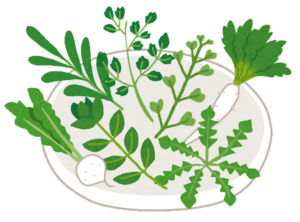
秋の七草
万葉集に収められた山上憶良の歌に日本の代表的秋草が詠まれたことに始まります。
春の七草が「七草粥」に入れて「食」を楽しむものですが、秋の七草は観賞用として花を「見」て楽しむものになります。
萩(はぎ)
薄(すすき)
桔梗(ききょう)
撫子(なでしこ)
葛(くず)
藤袴(ふじばかま)
女郎花(おみなえし)
四神獣
中国・朝鮮・日本において、天の四方の方角を司ると伝統的に信じられてきた神獣のことを云います。
四神にはそれぞれ司る方位、季節、色があります。
青龍 東 春 緑(青)
朱雀 南 夏 赤(朱)
白虎 西 秋 白(白)
玄武 北 冬 黒(緑)
三社祭では、本社神輿が納められている神輿庫に、この四神獣を描いた四神旗が飾られます。
恵比須様御縁日
10月は「神無月」とも云われ、全国の神様が出雲に集まります。その間、留守を預かり守ってくれるのが恵比須様といわれています。
恵比須様は、鯛を抱え柔和な笑みを浮かべる姿で馴染みのある、商売繁昌の神さまです。
神無月の間、留守を守ってくれる恵比須様に感謝し、10月20日を御縁日とし、商売繁昌や五穀豊穣を祈願します。
昔は、商家が親類や知人を招いて恵比須様を祭り、鯛を供えたりみかんを配ったりして景気良くお祝いをしたそうです。
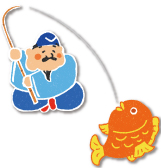
数え年
年齢の数え方には「満年齢」と「数え年」の二つがあります。現代では生まれた時点を0歳と考え、以後誕生日毎に1歳ずつ加えていく「満年齢」が一般的です。
これに対して、「数え年」とは、生まれた時点を1歳と数え、その後正月を迎えるたびに一つずつ歳を加えていく数え方です。
つまり、母親の胎内にある時から命を思う「魂の年齢」を数えるのが数え年と言えるでしょう。
歳祝い(還暦 古希 喜寿 傘寿 米寿 卒寿 白寿)
歳祝いは、神さまの恩により長寿を得られたことに感謝し、一層長生きできるように願います。また、長い人生を振り返り、その中で成してきたことを子孫に伝え、一家の繁栄をお祈りします。
使われている漢字にはそれぞれ意味があります。
・還暦(かんれき) 60歳
本来、干支は、「十二支」と「十干」の組み合わせからなっており、60年で一巡します。自分の生まれ年の干支に戻る60歳を「元の暦に還る」として、還暦の由来となりました。
・古希(こき) 70歳
古来より70歳まで生きることは「希(まれ)」という意味で、70歳のお祝いを古希と呼ぶようになりました。
・喜寿(きじゅ) 77歳
喜を草書体で書くと「」で七十七と読めることから77歳のお祝いを喜寿と呼ぶようになりました。
・傘寿(さんじゅ) 80歳
「傘」の略字「」が八十に見えることから80歳のお祝いを傘寿と呼ぶようになりました。
・米寿(べいじゅ) 88歳
米という字が「八十八」の字で成り立っているため、88歳のお祝いを米寿と呼ぶようになりました。
・卒寿(そつじゅ) 90歳
「卒」の略字「卆」が九十に見えることから90歳の祝いを卒寿と呼ぶようになりました。
・白寿(はくじゅ) 99歳
「百」から「一」を引くと「白」になるため、99歳の祝いを白寿と呼ぶようになりました。
※寿は「長寿」を意味します。
神社知識
鳥居

鳥居は神社の象徴となっていますが、これは神社の入り口に建つ門の一種であり、神様の聖域と人間世界との境界線を示したものだといわれています。
大きな神社ではたいがい二つ以上の鳥居がありますが、その場合は外側にある鳥居から、一の鳥居、二の鳥居、三の鳥居と呼んでいます。
鳥居の起源についてはいろいろな説がありますが、天照大御神(あまてらすおおみかみ)が岩戸隠れのとき、鶏(常世の長鳴鳥)を止まり木にとまらせて鳴かせたところ、それによって大御神が岩戸から出てこられたことから、或いは天孫降臨の際、鶏が道案内をつとめたから、などと云われています。
鳥居をくぐる際は、一礼をしましょう。
参道
参道とは、神社や寺院に参詣するための道を指します。
山門や鳥居をくぐって本殿へ続く道は、山道や、石畳、玉砂利が敷き詰められていたりと様々です。
参道の真ん中は、「正中(せいちゅう)」と呼ばれ、神様の通り道とされています。そのため、参道の真ん中は歩かず、左右どちらかの端を歩きます。
人通りの多いメインの道を表参道と呼んで、脇道には地名や方角をつけた参道や、裏参道と呼ばれるものがあり、今でも地名にこの名前が残っている場所があります。
手水
昔、神社を参拝する前には川でお清めを行う「禊(みそぎ)」が行われていました。 しかし、時代と共にその都度川で身体を清めることは困難となり、参拝前に手水舎で手と口を清める現在の形へと変化しました。 神社の鳥居をくぐると、そこから先は神様の聖域となります。 私たちは日々の生活の中で、知らず知らずのうちに罪・穢れに触れていることから、参拝する前に手水舎で身と心を清めます。
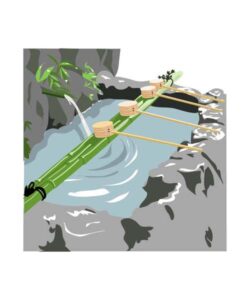
一、右手で柄杓に清水を汲み、左手を清める。
二、左手に柄杓を持ち変え、同様に右手を清める。
三、再び右手で柄杓を持ち、左の手のひらに水を溜めて口をすすぐ。
※柄杓に直接口をつけてはいけません。
口をすすぎ終わって、もう一度左手を清める。
四、両手で柄杓を持って柄杓を立て、残っている水で持ち手部分を清めてから、元の位置に伏せて置く。
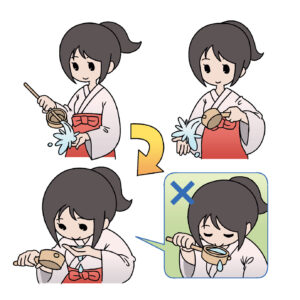
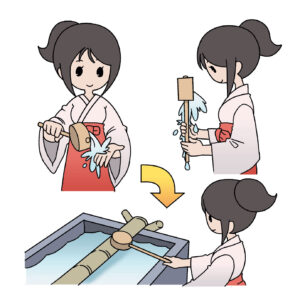
御朱印
神社を参拝した証として戴く「御朱印」ですが、その起こりは、奈良・平安時代に神社仏閣に書写した経典を奉納した際に受ける「納経受取(のうきょううけとり)の書付」と云われています。
当時は神仏習合思想の影響があり、仏教の経典を神社へも奉納していたようです。
こうした納経は徐々に一般にも広がり、やがて納経をせず参拝のみをした場合にも証明書を書いてもらうというように変化していったものと考えられています。
鉄道網が整備された明治以降には、巡拝旅行と集印が盛んに行われるようになりました。それに伴って、案内本や旅行記といった書物も出版されるようになり、昭和10年頃から「御朱印」という呼称が見られるようになります。
玉串
玉串奉奠(たまぐしほうてん)を正しくは「玉串を奉(たてまつ)りて拝礼」といいます。改まった参拝や祈祷、祭典に参列したときなどには、神様へ「玉串」を奉って拝礼します。
「玉串」とは榊(さかき)や杉などの常緑樹の小枝に紙垂(しで)や木綿(ゆう)をつけたものです。
神前にお供えするものとして、お米や酒、魚などと同様の意味があると考えられています。しかし、玉串は祭典の中で捧げて拝礼することから特別な意味を持ちます。神様に敬意を表し、且つ神威を受けるために祈念を込めて捧げるものです。
玉串奉奠の作法

一、玉串を両手で受け取り、左手の手のひらに乗せる形で、右手で玉串の根本を持つ。
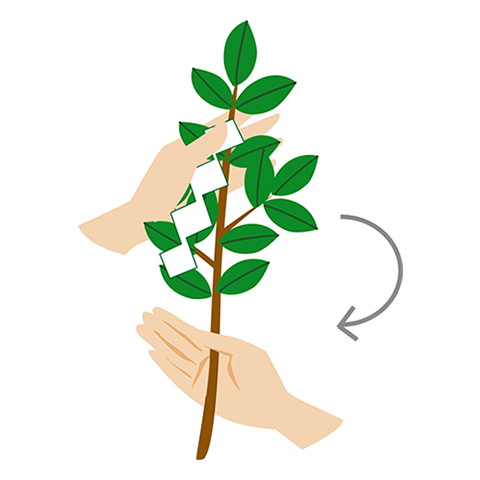
二、右手で玉串の根本を自分の体の方に向け、左手を右手に添える。
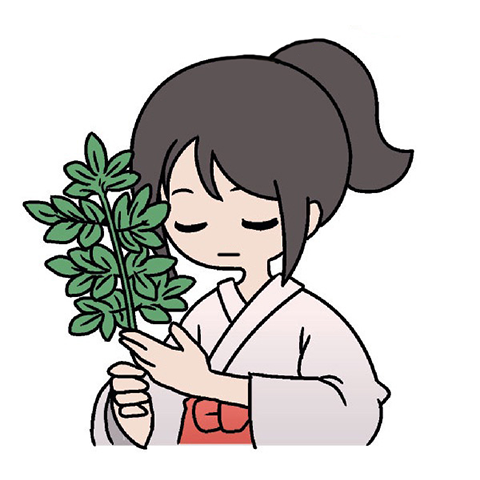
三、玉串を自分の顔に寄せ、数秒間ご祈念申し上げる(願意を込める)。
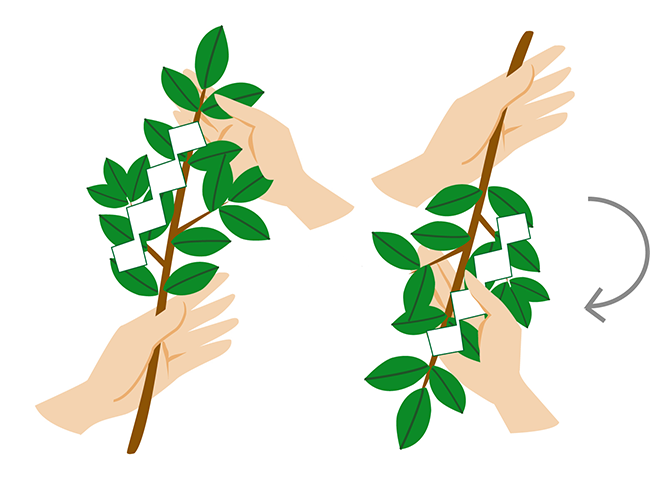
四、右手で玉串の上の方(葉部分)を持ち、時計回りに回して根本を神前へと向ける。

五、左手を右手に添え直し、玉串の葉を両手で持つ。
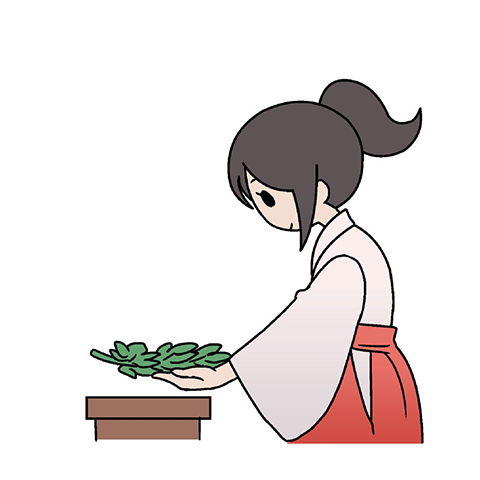
六、神前に一歩進み、案の上に玉串を両手でお供えし、一歩下がる。
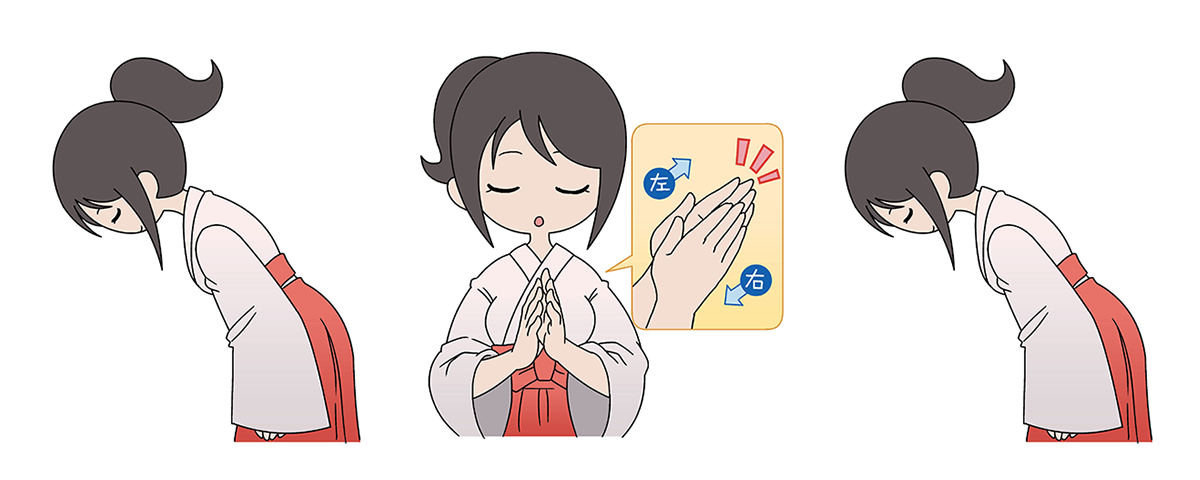
七、気持ちを整え、神様に対し「二礼二拍手一礼」の作法で拝礼する。
注意点:神様に対して「お願い事を申し上げる」という気持ちを忘れないこと。
榊
生命力あふれる常緑樹には神様が宿ると考えられ、古くから神事に用いられてきました。神様と私たちとの境を示す「境木」、栄える「栄木」が転じたと云われます。
のし袋
神社で御祈祷をお受けになった際、御祈祷料をお納めになる時に使われるのが『熨斗袋(のしぶくろ)』です。
熨斗袋とは、『熨斗(のし)』や『水引』がついた袋のことです。予め印刷された物も多くあります。

熨斗の起源は、「のしアワビ」を、贈り物として添えていたことから始まります。 元来、アワビを細く伸ばして干したもので、当時貴重な保存食であり、長寿をもたらす食べ物とされてきました。
現在では右図のように簡略化され、アワビのかわりに黄色い紙が用いられるようになっています。現金を送る際の封筒にこの熨斗がつけられるようになりました。
神社でお祓いを受ける際には、この熨斗袋に一定の金額を包んでお納めします。表書きには『初穂料』または『玉串料』などと書きます。水引の下に、御祈祷をお受けになる方(初宮・七五三ではお祝い児)の名前を書きます。
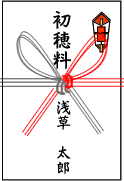
今ではお金を包むことが一般的になりましたが、昔は実りの秋には神さまに感謝の気持ちを込めて、その年の最初に実った稲穂を神さまにお供えしていました。稲穂(初穂)をご神前にお供えしたことにちなみ、神様にお供えする金銭のことを『初穂料』と表すようになりました。またご神前に拝礼する際に玉串(榊の小枝に紙垂を付けたもの)を奉ることから『玉串料』とも言われます。また、玉串料という表書きは、慰霊祭などの霊祭や弔事の際にも使用できます。その他「御供」「御神前」などがよく用いられる表書きです。
本来は、慶事、弔事とも表書きは毛筆が原則です。お祝い事には濃い黒を、葬式などの場合は薄墨で書きます。毛筆が苦手だという方も、万年筆やボールペンでは無作法とみなされてしまいます。最低でも黒のサインペンを使って下さい。
熨斗袋は神社以外でも、慶弔時に現金を送る際に利用されますが、祝儀・不祝儀などの種類があります。水引の色や結び方、熨斗の有無で用途が変わってきます。
狛犬
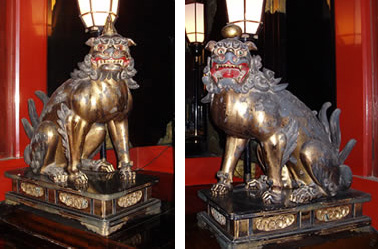
狛犬は「高麗犬」「胡麻犬」とも書き、神社社殿前や参道などに置かれた一対の獣形像のことをいいます。狛犬の原形はオリエント、インドにおけるライオン像で、それが中国大陸そして朝鮮半島を経て渡来しました。沖縄県では「シーサー」といわれる獅子が、各家の屋根に魔よけとして置かれていますが、神社の狛犬も同様に、邪を退け、神前守護の意味があります。
材質は石が多く見られますが、木や銅、鉄製のものなどもあり、一般的に雌雄で一対になっています。また、片方は口を開け(阿)、もう片方は口を閉じ(吽)ているものが多くみられます。「阿吽(あうん)の呼吸」という表現はここから来ていると考えられています。
神宮大麻(じんぐうたいま)
神社で大麻というと伊勢神宮のお神札のことを指します。
「大麻」とは本来「おおぬさ」とも読み、神々への捧げ物、お祓いの際に用いられる木綿や麻をさします。いつしか、神宮で厳重なお祓いを経て授けられる清らかな神札を「たいま」と呼ぶようになりました。
伊勢神宮でお祀りされている太陽の神様「天照大神(あまてらすおおみかみ)」は、日本で最も尊い神様とされています。
神宮大麻は神棚では真ん中、もしくは一番前に飾りましょう。
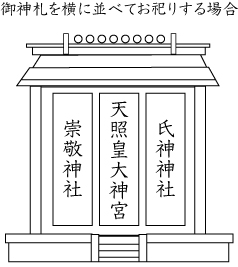

神棚の祀り方
神棚は、家族や社員が集まる明るく綺麗な部屋の天井近くに、南か東に向く様にお祀りします。※北側の壁に設置して南向き、又は西側の壁に設置して東向き
目の位置よりも高く設置するようにします。
建物の造りによって難しい場合は、そこまで方角にこだわる必要はありません。その場所が神棚を設置し、お神札を丁寧にお祀りできる場所であれば大丈夫です。
神様への敬いをもってお祀りすることが大切です。
お神札の納め方は、神棚の形によって変わります。
扉が三つある神棚は、中央に神宮大麻、向かって右側に氏神神社のお神札、左側に崇敬神社のお神札を祀ります。
扉が一つしかない神棚は、手前から神宮大麻、氏神神社のお神札、崇敬神社の順に重ねてお祀りします。
古いお札の納め方
年の暮れには大掃除をして、新しい年を迎える準備をしますが 同様に、神棚もきれいにして新しいお神札をおまつりします。 一年間お守りいただいたことに感謝申し上げてからお札を受けた神社へ納めて『お焚き上げ』してもらい 新しいお神札をお受けします。遠くの神社で受けたお神札を納めに行くのが大変な場合は 近くの神社でお焚き上げしてもらっても構いません。
多くの神社では大晦日から一月十五日までの間に左義長やどんど焼きなどが行われ古いお神札や、お正月飾りのお焚き上げを行います。
浅草神社では年末(12月25日前後)に境内に古札納所を設置致しますので、1月15日までにそちらにお納め下さい。
絵馬
絵馬は祈願または祈願成就の証として、奉納するものになります。絵馬の形は、板の上部を山形にしたものが大半を占め、これにそれぞれの願い事を書いて奉納します。
日本では古くから神様の乗り物として馬が神聖視され、お祭りや祈願の時には神馬(じんめ)といって生きた馬を神社に奉納する風習がありました。
その代わりに板に馬の絵を描き、奉納するようになったのが絵馬の起源とされています。
絵馬が一般大衆に広まったのは鎌倉時代以降のことです。その頃から、馬の絵の他にご祭神と関わりのある様々な動物(狐や蛇など)も描かれるようになりました。さらに時代が下るにつれ、図柄は多様化していきました。
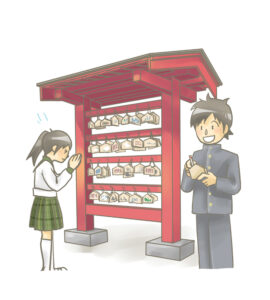
破魔矢
破魔矢とは魔除けのための縁起物で、多くは正月に社寺で授与されます。
矢を放つ破魔弓、矢の先に鏑(かぶら)をつけた鏑矢(かぶらや)などがあります。
弓矢は武器ですが、魔を祓う力もあると考えられています。
破魔矢は、神棚、床の間、玄関、リビングなどに飾ります。
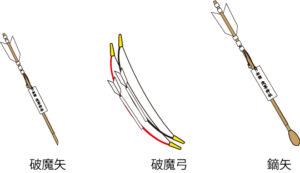
注連縄
注連縄(しめなわ)は、神社だけでなく、木や岩などにも張られ、その場所は神が宿る神聖な場所で、神域と現世を隔てる境界・結界であり、厄や禍を祓ったりする役割があると言われています。
縄の途中には藁の房で作られた「〆の子」や、紙を特殊な断ち方で折った「紙垂(しで)」が取り付けられています。
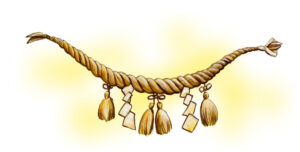
神輿
神様は、普段神社の本殿(社殿)に鎮まっていますが、お祭り(祭礼)の際には本殿よりお出ましになります。その時の乗り物が神輿です。 神輿は、神社の本殿を模して小型化したものが多く、屋根の中央には鳳凰や擬宝珠があしらわれています。 神輿に御神霊をお移しして、各町を渡御することで神様に町をご覧いただきます。 また、神輿を上下左右に振り動かし、わざと激しく揺さぶることで神輿に座す神様の「魂振り(たまふり)」を行うことで、神様の霊威を高めそのお力を町の隅々まで行き渡らせ、商売繁盛、家内安全、豊作や豊漁、疫病の退散がなると信仰されています。
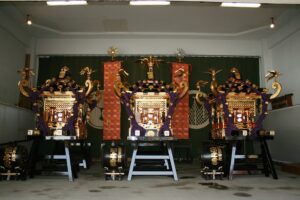
浅草神社には3基の宮神輿があり、祭礼の際は、 一之宮に土師真中知命 二之宮に檜前浜成命 三之宮に檜前武成命 の御神霊をそれぞれにお移しし、浅草の町を渡御します。
祝詞
お祭り事を行う時、必ず御神前で奏上するのが祝詞です。
祝詞というのは、初めは神の言葉そのものを指していましたが、のちに神に奏上する言葉を祝詞というようになったのです。
祝詞は、神代の時代、天児屋根命(あめのこやねのみこと)が天の岩戸の前で奏上したのが始まりとされています。
歳神様
お正月を迎えるにあたり、大掃除をしてお正月飾りを飾りますが、これは「歳神様」をお迎えするための準備です。
お正月の本来の目的は、この歳神様をお迎えすることで、来る一年の無事を願います。
歳神様とは「年神様」「大年神」とも記されることがあります。
一般的には「稲の実り」を示す穀物・農耕の神様とされていますが、「祖霊」すなわち祖先の霊として迎えている地域もあります。
この歳神様は「来訪神」とも言われ、新年の日の出とともに来臨するので、お正月の神様の所以ともなっています。
この歳神様をお正月に自宅へ招き入れるために、さまざまな準備をするのです。
はにわ
古墳の上や周囲に並べられた主に素焼きの焼き物のことです。はにわは死者の魂を守ったり鎮めたりするものと考えられています。
人の形を象ったもののほか、馬の形をしているものも出土しています。
大昔、貴人が死去するとその墓の周りに生前付き従っていた人々を生き埋めにする殉死の風習がありました。
相撲の神様として有名な野見宿禰が、土で作った人物や馬を生きた人に替えて古墳の周りに並べてはどうかと天皇に進言し、以来、生きた人の代わりにはにわが古墳に供えられるようになりました。
野見宿禰は、古墳に立てるはにわや土器を造って葬礼儀礼を司り、後に土師姓を賜りました。
当社のご祭神である「土師真中知命」はその子孫にあたります。
